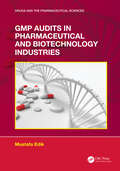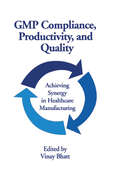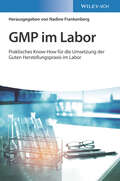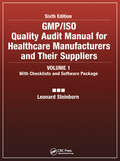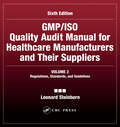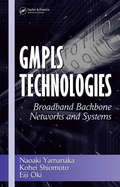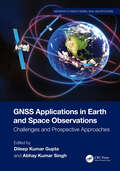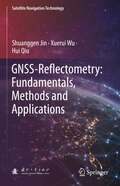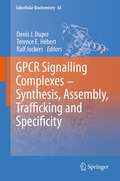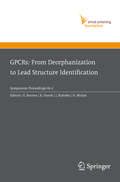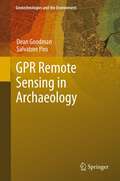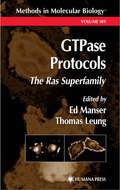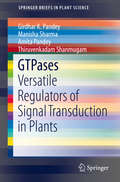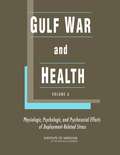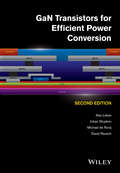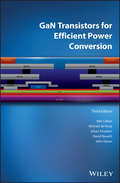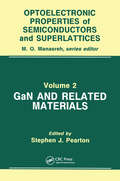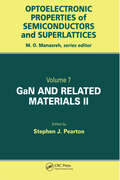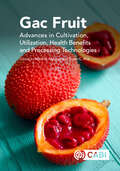- Table View
- List View
GMP Audits in Pharmaceutical and Biotechnology Industries (ISSN)
by Mustafa EdikThe fact that good manufacturing practice (GMP) audits in the pharmaceutical and biotechnology industries have to be evaluated, and with very limited resources, has created a gap in this field. The lack of trained and qualified GMP auditors is on the rise in all organizations that are required to implement FDA, EMA, MHRA, WHO, TGA, and PIC/S regulations. This volume is an essential reference source for those organizations operating in the field of health and presents the basic knowledge needed to perform audits. The author also provides useful tips and a selection of samples about GMP audits that are indispensable for professionals and health inspectors working in industry and health authorities.Features An essential reference source for those organizations operating in the field of health and presents the basic knowledge needed to perform audits Anyone working in the manufacturing sector needs to be aware of GMP, be able to identify operational flaws as well as legal violations, and have a clear understanding of how to meet GMP standards Assists readers in understanding the importance of GMP and how they can apply each aspect in their working environment Covers a global regulatory landscape Suitable for relevant degree courses including industrial pharmaceutics and pharmaceutical biotechnology
GMP Compliance, Productivity, and Quality: Achieving Synergy in Healthcare Manufacturing
by Vinay BhattWritten by twenty-eight experts, filled with recommendations that can immediately be put into action, this book provides the strategies and tactics required to link and harmonize manufacturing processes with GMP to achieve optimum operability and cost-effective regulatory compliance. Drawn from name brand and generic companies and regulatory and co
GMP im Labor: Die Gute Herstellungspraxis im Labor praktisch umgesetzt
by Nadine FrankenbergGMP im Labor Der perfekte Leitfaden für Neulinge und Quereinsteiger:innen zur Etablierung eines GMP-konformen Qualitätssystems mit besonderem Augenmerk auf die speziellen Bedürfnisse im Labor Good Manufacturing Practice (GMP) oder gute Herstellungspraxis ist ein System zur Qualitätssicherung von Herstellungsprozessen und Produkten basierend auf nationalen und internationalen Gesetzen. Dabei beziehen sich die Richtlinien auf Produktionsabläufe und -umgebung in der Herstellung von Arzneimitteln und Wirkstoffen, aber auch bei Kosmetika, Lebens- und Futtermitteln. GMP im Labor beschäftigt sich mit der Umsetzung von GMP-Anforderungen in der Laborpraxis und präsentiert eine Grundlage für die Etablierung eines GMP-konformen Qualitätssystems. Besonders nützlich für Einsteiger:innen werden die speziellen Bedürfnisse im Laboralltag detailliert beleuchtet und praktische Lösungsansätze geboten. Dabei wird genauer auf die gesetzlichen Grundlagen und Abgrenzung zu anderen Systemen (GLP, GCP, ISO, etc.) eingegangen und die verschiedenen Punkte eines Qualitätssystem wie etwa Dokumentation, Validierung und Risikomanagement beleuchtet. Des Weiteren werden die fundamentalen Prozesse in einem GMP-konformen Qualitätssystem, wie etwa Gerätequalifizierung, Abweichungen und Selbstinspektionen, behandelt und mit praktischen Lösungsansätzen präsentiert. Dringend benötigt: Das einzige Buch, das einen umfassenden und doch komprimierten Einblick in die komplexe GMP Thematik bietet Praxisnah: Es wird besondere Rücksicht auf die speziellen Bedürfnisse im Labor genommen und bietet praktische Lösungsansätze Leitfaden: Behandelt die notwendigen Grundlagen und dient als Leitfaden zur Etablierung eines GMP-konformen Qualitätssystems GMP im Labor richtet sich an Studierende in Bachelor und Master Studiengängen, Doktorand:innen, Naturwissenchaftler:innen, sowie Mitarbeiter:innen in Laboratorien und in der Industrie.
GMP-Qualifizierung und Validierung von Wirkstoffanlagen: Ein Leitfaden für die Praxis
by Ralf GengenbachUnter Validierung bzw. Qualifizierung versteht man die Beweisf hrung, dass Verfahren, Prozesse, Ausr stungsgegenst nde, Materialien, Arbeitsg nge oder Systeme tats chlich zu den erwarteten Ergebnissen f hren. Betroffen sind alle Unternehmen, die Rohstoffe, Halbfertig- oder Fertigprodukte f r medizinische Ger te, Pharmazeutika, Diagnostika, Lebensmittel herstellen. Ebenso sind Labore betroffen, die Dienstleistungen anbieten, deren Ergebnisse direkt in den Herstellungsprozess einflie en. Dieses Buch liefert "harte Fakten" hinsichtlich der Durchf hrung (How to do) von praxiserprobten Qualifizierungs- und Validierungsma nahmen - ein "Must have" f r Wirkstoff- und Arzneimittelhersteller sowie deren Zulieferer. Der deutsche Titel zur Validierung und Qualifizierung
GMP/ISO Quality Audit Manual for Healthcare Manufacturers and Their Suppliers, (Volume 1 - With Checklists and Software Package): Regulations, Standards, And Guidelines
by Leonard SteinbornVolume 1 of this two-part package provides a complete set of checklists for internal and contract device and drug manufacturers and developers, contract software developers, and suppliers of chemical, printed material, electronic component, and general supplies. It also includes a simulated QSIT audit, and a new-product market launch. All of these
GMP/ISO Quality Audit Manual for Healthcare Manufacturers and Their Suppliers, (Volume 2 - Regulations, Standards, and Guidelines): Regulations, Standards, and Guidelines
by Leonard SteinbornThis well-known QA manual has been updated to provide the guidance readers need to assess their compliance with standard regulations. This Volume 2 of a three-part package contains the full text on: * FDA regulations* EC and IPEC guidelines* ISO/BSI standards referenced in the checklists furnished in volume 1Easy-to-read and organized to provide fa
GMPLS Technologies: Broadband Backbone Networks and Systems (Optical Science and Engineering #101)
by Eiji Oki Naoaki Yamanaka Kohei ShiomotoMulti-Protocol Label Switch (MPLS) and Generalized MPLS (GMPLS) are key technologies for next-generation IP backbone networks. Until now, however, engineers have been forced to search for technical papers on this subject and read them in an ad-hoc manner. At last there is a book that explains both MPLS and GMPLS concepts in a systematic way. GMPLS Technologies: Broadband Backbone Networks and Systems addresses the basic concepts, network architectures, protocols, and traffic engineering needed to operate MPLS and GMPLS networks. The book begins with an introduction of the nature and requirements of broadband networks. It describes the basics of control-oriented networks and Internet Protocol (IP).The text then examines the fundamentals of MPLS, explaining why MPLS is preferable to IP packet-based forwarding. This volume covers MPLS applications, details IP router structures, illustrates GMPLS, and explores important studies on traffic engineering in GMPLS Networks. The text concludes with a description of IP, MPLS, and GMPLS standardization topics. Network equipment design engineers and network service provision engineers can reference this book to understand the crucial techniques for building MPLS/GMPLS-based networks.FeaturesAddresses the basic concepts, network architectures, protocols, and traffic engineering needed to operate MPLS and GMPLS networksCovers the fundamentals of connection-oriented networks including TCP/IP, flow control mechanism, and ATM protocolAnalyzes MPLS issues and applications, such as label switched paths (LSPs) and VPNsHighlights IP router structures, examining technologies of data path function - switch architecture, packet scheduling, and forwarding engineExplores multi-layer traffic engineering, survivable networks, and wavelength-routed optical networksDemonstrates GMPLS-based routers
GNSS Applications in Earth and Space Observations: Challenges and Prospective Approaches (Microsatellite Remote Sensing, GNSS, and Applications)
by Abhay Kumar Singh Dileep Kumar GuptaGlobal Navigation Satellite Systems (GNSSs) have become an essential technology used in navigation, positioning, and timing applications in meteorology, environmental monitoring, disaster management, and space exploration. This comprehensive book explores the various applications of GNSS technology in different fields of Earth and Space observations and provides researchers, professionals, and students valuable insights into these emerging trends. It discusses the challenges that impact the performance of GNSS technology and offers solutions through several case studies on Space weather and climate disasters, opening a different dimension of approaches in various paradigms of GNSS technology.Features: Covers the most up-to-date GNSS applications in three major areas related to Earth and Space observations: climate studies, disaster management, and Space weather monitoring Includes case studies of best practices in climate studies and disaster management Explains the impacts of Space weather events on the near-Earth environment Describes limitations and future possibilities of better use of GNSS in Earth and Space observation and monitoring Highlights an integrated and interdisciplinary approach valuable to a wide range of readers studying Earth and Space interactions This book is a valuable resource for professionals, researchers, academics, and students in Remote Sensing and GIS, Earth Science, Physics and Electronics, Climate Studies, Disaster Management, Geophysics, and Space Science.
GNSS Systems and Engineering: The Chinese Beidou Navigation and Position Location Satellite
by Shusen TanComprehensive guide to the fundamentals and advanced engineering of the Beidou satellite system • The first book specifically describing the Chinese Beidou timing/navigation system – an increasingly important contributor to the GNSS• Introducing the ‘user location information sharing’ demands, technologies and development trends• Highlights the technical features and broad application prospects of navigation, positioning and short message communication of the Beidou satellite system• Enhances understanding of the fundamentals and theories of radio navigation and positioning satellite systems• Offers guidelines as to how to implement their design and construction• A comprehensive reference on the subject for those who are doing scientific or engineering research in this area
GNSS-Reflectometry: Fundamentals, Methods and Applications (Satellite Navigation Technology)
by Shuanggen Jin Xuerui Wu Hui QiuThis book gives comprehensive introduction to the fundamentals, methods and applications of GNSS-Reflectometry (GNSS-R), including GNSS-R history, GNSS reflection signal characteristics, ground-based GNSS multipath reflectometry, interference pattern technology, delay Doppler map, space-based GNSS-R theory, ocean altimetry, hydrological remote sensing, vegetation monitoring and cryosphere remote sensing, etc. It well presents the current status and the latest application progress in this field. The authors have been engaged in the research and application of GNSS-R for many years with achieving lots of original theoretical and application progress, such as GNSS-R scattering mechanism and new applications, which reflect the forefront trends and cutting-edge dynamics in this discipline. It has important reference value and application prospect for marine monitoring, environment remote sensing, global change monitoring, glacier and permafrost monitoring, meteorological and agricultural application and so on. This book is suitable for professionals, graduate students, and researchers engaged in satellite navigation, remote sensing, space geodesy, marine environment, meteorological services, and global change, and as well as technical support for engineers and transformation applications, especially those engaged in satellite navigation development and environmental remote sensing applications. The basis of English translation of this book, originally in Chinese, was facilitated by artificial intelligence. The content was later revised completely by the authors for accuracy.
GPCR Signalling Complexes – Synthesis, Assembly, Trafficking and Specificity
by Terence E. Hébert Ralf Jockers Denis J. DupréMain Question: G protein coupled receptors are involved in highly efficient and specific activation of signalling pathways. How do GPCR signalling complexes get assembled to generate such specificity? In order to answer this question, we need to understand how receptors and their signalling partners are synthesized, folded and quality-controlled in order to generate functional proteins. Then, we need to understand how each partner of the signalling complex is selected to join a complex, and what makes this assembly possible. GPCRs are known to be able to function as oligomers, what drives the assembly into oligomers and what will be the effects of such organization on specificity and efficacy of signal transduction. Once the receptor complexes are assembled, they need to reach different locations in the cell; what drives and controls the trafficking of GPCR signalling complexes. Finally, defects in synthesis, maturation or trafficking can alter functionality of GPCRs signalling complexes; how can we manipulate the system to make it function normally again? Pharmacological chaperones may just be part of the answer to this question.
GPCRs as Therapeutic Targets
by Annette GilchristA thorough discussion of the structure, pharmacology, function, and role of G protein-coupled receptors In GPCRs as Therapeutic Agents, distinguished researcher Dr. Annette Gilchrist delivers an authoritative and in-depth compendium of a vibrant and active area of academic and industrial drug discovery. The book serves as an important reference for new and experienced researchers studying G protein-coupled receptors and discusses the molecular pharmacology of this important target class. It also includes up-to-date material on GPCR structures and structure-based drug design. The book explores the role of GPCRs in the treatment of disease and novel approaches to their study. In addition to providing information on the structure, pharmacology, and function of GPCRs, it discusses their role in disease states, and advances new methods for measuring GPCR activity in an accessible and engaging way. The book includes: A thorough introduction to the molecular pharmacology of G protein-coupled receptors, including up-to-date material on GPCR structures and structure-based drug design In-depth discussions of the evolving pharmacology for GPCRs, intracellular trafficking, and subcellular GPCR signaling Comprehensive explorations of allosteric modulation, receptor dimerization, deorphanization, and ubiquitination Fulsome treatments of the role played by GPCRs in the treatments of cancer, substance use disorders, cerebrovascular diseases, and metabolic diseasesPerfect for researchers in biochemistry, cell biology, and pharmacology, GPCRs as Therapeutic Agents will also earn a place in the libraries of professionals working in medicinal chemistry, structural biology, and clinical pharmacology.
GPCRs: From Deorphanization to Lead Structure Identification
by H. Bourne J. Kuhnke H. Michel Richard HorukThis book offers an insight into the approaches taken by industry and academia to address GPCRs and depict how mature this target class-oriented research has become in the last decade. Coverage also reflects the actual trends in the fast-emerging field of GPCR research in academia and industry. It is based on the international workshop GPCRs: From Deorphanisation to Lead Structure Identification, held in Berlin in May 2006.
GPR Remote Sensing in Archaeology
by Dean Goodman Salvatore PiroGPR Remote Sensing in Archaeology provides a complete description of the processes needed to take raw GPR data all the way to the construction of subsurface images. The book provides an introduction to the "theory" of GPR by using a simulator that shows how radar profiles across simple model structures look and provides many examples so that the complexity of radar signatures can be understood. It continues with a review of the necessary radargram signal processes needed along with examples. The most comprehensive methodology to construct subsurface images from either coarsely spaced data using interpolation or from dense data from multi-channel equipment and 3D volume generation is presented, advanced imaging solutions such as overlay analysis are introduced, and numerous worldwide site case histories are shown. The authors present their studies in a way that most technical and non-technical users of the equipment will find essentials for implementing in their own subsurface investigations.
GPU Solutions to Multi-scale Problems in Science and Engineering
by David A. Yuen Wei Ge Lennart Johnsson Long Wang Xuebin Chi Yaolin ShiThis book covers the new topic of GPU computing with many applications involved, taken from diverse fields such as networking, seismology, fluid mechanics, nano-materials, data-mining , earthquakes ,mantle convection, visualization. It will show the public why GPU computing is important and easy to use. It will offer a reason why GPU computing is useful and how to implement codes in an everyday situation.
GTPase Protocols
by Ed Manser Thomas LeungEdward J. Manser and Thomas Leung have collected the key techniques currently in use to probe the function of these ubiquitous proteins both in vitro and in vivo. Presented in a format that ensures ready reproducibility by accomplished experimentalists who have refined the various methods in their laboratories, each technique includes step-by-step instructions, tips on avoiding pitfalls and troubleshooting, and ancillary notes explaining how to adapt each procedure in the event of problems. The methods cover the spectrum of core techniques required for the five major GTPase subfamilies (Ras, Rho, Rab, Arf, and Ran) and permit a diversity of applications ranging from structural studies on a GTPase to real time in vivo analysis. Timely and highly practical, GTPase Protocols: The Ras Superfamily illuminates the powerful techniques used by investigators today to study this special family of proteins that plays such important roles in human health and disease.
GTPases
by Amita Pandey Girdhar K. Pandey Manisha Sharma Thiruvenkadam ShanmugamG proteins are the key regulators for a wide range of cellular processes in animals and plants. In comparison to animals and yeast, plants have a single Rho-GTPase subfamily called Rho-like GTPases (ROPs). The ROP family of monomeric GTPases has emerged as a versatile and key regulator in plant signal transduction processes. During the past few years' studies on plant RHO-type (ROP) GTPase have generated new insights into their role in diverse processes ranging from cytoskeletal organization, polar growth, development to stress and hormonal responses. Studies have shown that plants have evolved specific regulators and effector molecules. ROP GTPases possess the ability to interact with these multiple regulator and effector molecules that ultimately determines their signaling specificity. Recently, genome wide studies in plants have shown that the Arabidopsis genome encodes 93, and rice has nearly 85 small GTPase homologs. And we have been able to identify four new homologs in the rice genome. Here, we focus on the complete phylogenetic, domain, structural and expression analysis during stress and various developmental processes of small GTPases in plants. The comparison of gene expression patterns of the individual members of the GTPase family may help to reveal potential plant specific signaling mechanisms and their relevance. Also, we are summarizing the role of currently known ROP GTPases and their interacting proteins with brief description, simultaneously, comparing their expression pattern based on microarray data. Overall, we will be discussing the functional genomic perspective of plant Rho like GTPases and their role in regulating several physiological processes such as stress, hormonal, pollen tube, root hair-growth and other developmental responses.
GUATEMALA: Human Rights and the Myrna Mack Case
by Committee on Human RightsTwo members of the Committee on Human Rights (CHR), NAS member Mary Jane West-Eberhard and NAS/NAE member Morton Panish, undertook a mission to Guatemala to observe the trial of two high-level Guatemalan military officials who were charged with ordering the murder of Guatemalan anthropologist Myrna Mack. She was stabbed to death in 1990, two days after a report for which she was principal researcher, “Assistance and Control: Policies Toward Internally Displaced Populations in Guatemala,” was published by the Georgetown University Press. Ms. Mack had been doing research on and writing about the unjust treatment of the internally displaced people in Guatemala. Thirteen years after Ms. Mack’s murder—after the case had gone through dozens of courts and countless delays—a general and colonel in the Guatemalan military intelligence apparatus were brought to trial, and one was convicted. This marked the first time in Guatemalan history that a high-level military official had been brought to justice for atrocities he committed during Guatemala’s 30-year civil war. This report summarizes the one-month trial proceedings.
GULF WAR and HEALTH: HEALTH EFFECTS OF SERVING IN THE GULF WAR
by Institute of Medicine of the National AcademiesIn 1998, in response to the growing concerns that many returning Gulf War veterans began reporting numerous health problems that they believed to be associated with their service in the Persian Gulf, Congress passed two laws which directed the Secretary of Veterans Affairs to enter into a contract with the National Academy of Sciences. They were tasked to review and evaluate the scientific and medical literature regarding associations between illness and exposure to toxic agents, environmental or wartime hazards, and preventive medicines or vaccines associated with Gulf War service. In addition, the Institute of Medicine of the National Academy of Sciences provided conclusions to these studies that were considered when making decisions about compensation to veterans. Gulf War and Health Volume 4: Health Effects of Serving in the Gulf War summarizes in one place the current status of health effects in veterans deployed to the Persian Gulf irrespective of exposure information. This book reviews, evaluates, and summarizes both peer-reviewed scientific and medical literature addressing the health status of Gulf War veterans.
GULF WAR and HEALTH: VOLUME 6
by Institute of Medicine of the National AcademiesThe sixth in a series of congressionally mandated reports on Gulf War veterans' health, this volume evaluates the health effects associated with stress. Since the launch of Operation Desert Storm in 1991, there has been growing concern about the physical and psychological health of Gulf War and other veterans. In the late 1990s, Congress responded by asking the National Academy of Sciences (NAS) to review and evaluate the scientific and medical literature regarding associations between illness and exposure to toxic agents, environmental or wartime hazards, and preventive medicines or vaccines in members of the armed forces who were exposed to such agents. Deployment to a war zone has a profound impact on the lives of troops and on their family members. There are a plethora of stressors associated with deployment, including constant vigilance against unexpected attack, difficulty distinguishing enemy combatants from civilians, concerns about survival, caring for the badly injured, and witnessing the death of a person. Less traumatic but more pervasive stressors include anxiety about home life, such as loss of a job and income, impacts on relationships, and absence from family. The focus of this report, by the Institute of Medicine (IOM) Committee on Gulf War and Health: Physiologic, and Psychosocial Effects of Deployment-Related Stress, is the long-term effects of deployment-related stress. Gulf War and Health: Volume 6. Physiologic, and Psychosocial Effects of Development Related Stress evaluates the scientific literature regarding association between deployment-related stressors and health effects, and provides meaningful recommendations to remedy this problem.
GaN Transistors for Efficient Power Conversion: The Egan Fet Journey Continues
by Alex Lidow Michael De Rooij Johan Strydom David ReuschGallium nitride (GaN) is an emerging technology that promises to displace silicon MOSFETs in the next generation of power transistors. As silicon approaches its performance limits, GaN devices offer superior conductivity and switching characteristics, allowing designers to greatly reduce system power losses, size, weight, and cost. This timely second edition has been substantially expanded to keep students and practicing power conversion engineers ahead of the learning curve in GaN technology advancements. Acknowledging that GaN transistors are not one-to-one replacements for the current MOSFET technology, this book serves as a practical guide for understanding basic GaN transistor construction, characteristics, and applications. Included are discussions on the fundamental physics of these power semiconductors, layout and other circuit design considerations, as well as specific application examples demonstrating design techniques when employing GaN devices. With higher-frequency switching capabilities, GaN devices offer the chance to increase efficiency in existing applications such as DC-DC conversion, while opening possibilities for new applications including wireless power transfer and envelope tracking. This book is an essential learning tool and reference guide to enable power conversion engineers to design energy-efficient, smaller and more cost-effective products using GaN transistors. Key features: Written by leaders in the power semiconductor field and industry pioneers in GaN power transistor technology and applications. Contains useful discussions on device-circuit interactions, which are highly valuable since the new and high performance GaN power transistors require thoughtfully designed drive/control circuits in order to fully achieve their performance potential. Features practical guidance on formulating specific circuit designs when constructing power conversion systems using GaN transistors - see companion website for further details. A valuable learning resource for professional engineers and systems designers needing to fully understand new devices as well as electrical engineering students.
GaN Transistors for Efficient Power Conversion: The Egan Fet Journey Continues
by Alex Lidow Johan Strydom David Reusch John Glaser Michael de RooijAn up-to-date, practical guide on upgrading from silicon to GaN, and how to use GaN transistors in power conversion systems design This updated, third edition of a popular book on GaN transistors for efficient power conversion has been substantially expanded to keep students and practicing power conversion engineers ahead of the learning curve in GaN technology advancements. Acknowledging that GaN transistors are not one-to-one replacements for the current MOSFET technology, this book serves as a practical guide for understanding basic GaN transistor construction, characteristics, and applications. Included are discussions on the fundamental physics of these power semiconductors, layout, and other circuit design considerations, as well as specific application examples demonstrating design techniques when employing GaN devices. GaN Transistors for Efficient Power Conversion, 3rd Edition brings key updates to the chapters of Driving GaN Transistors; Modeling, Simulation, and Measurement of GaN Transistors; DC-DC Power Conversion; Envelope Tracking; and Highly Resonant Wireless Energy Transfer. It also offers new chapters on Thermal Management, Multilevel Converters, and Lidar, and revises many others throughout. Written by leaders in the power semiconductor field and industry pioneers in GaN power transistor technology and applications Updated with 35% new material, including three new chapters on Thermal Management, Multilevel Converters, Wireless Power, and Lidar Features practical guidance on formulating specific circuit designs when constructing power conversion systems using GaN transistors A valuable resource for professional engineers, systems designers, and electrical engineering students who need to fully understand the state-of-the-art GaN Transistors for Efficient Power Conversion, 3rd Edition is an essential learning tool and reference guide that enables power conversion engineers to design energy-efficient, smaller, and more cost-effective products using GaN transistors.
GaN and Related Materials
by 9789056995171Presents views on current developments in heat and mass transfer research related to the modern development of heat exchangers. Devotes special attention to the different modes of heat and mass transfer mechanisms in relation to the new development of heat exchangers design. Dedicates particular attention to the future needs and demands for further development in heat and mass transfer. GaN and related materials are attracting tremendous interest for their applications to high-density optical data storage, blue/green diode lasers and LEDs, high-temperature electronics for high-power microwave applications, electronics for aerospace and automobiles, and stable passivation films for semiconductors. In addition, there is great scientific interest in the nitrides, because they appear to form the first semiconductor system in which extended defects do not severely affect the optical properties of devices. This series provides a forum for the latest research in this rapidly-changing field, offering readers a basic understanding of new developments in recent research. Series volumes feature a balance between original theoretical and experimental research in basic physics, device physics, novel materials and quantum structures, processing, and systems.
GaN and Related Materials II
by Stephen J. PeartonThe first GaN and Related Materials covered topics such as a historical survey of past research, optical electrical and microstructural characterization, theory of defects, bulk crystal growth, and performance of electronic and photonic devices. This new volume updates old research where warranted and explores new areas such as UV detectors, microw
Gac Fruit: Advances in Cultivation, Utilization, Health Benefits and Processing Technologies
by Van Anh Le Servan Ersan Chuyen V. Hoang Tien Huynh Cang H. Mai Judith Müller-Maatsch Dao T. Nguyen Sophie E. Parks Huan Phan-Tai Huu Tai Pham Ngoc T.M Ta Xuan T. TranGac fruit, Momordica cochinchinensis Spreng, is rich in nutrients such as carotenoids (particularly ß-carotene and lycopene), fatty acids, vitamin E, polyphenol compounds and flavonoids. This book provides the latest research on this fruit, from cultivation through to novel processing technologies for health products. It addresses several techniques for propagation and cultivation in order to increase the production and quality of Gac fruit, including traditionally used parts of the fruit (aril) and those whose value has not yet been maximized (peel, pulp and seed). This plant has the potential to be a high value crop, particularly as parts of the fruit can be processed into nutrient supplements and natural colorants. Currently only the aril is commercially harvested, and this presents opportunities for upcycling the rest of the fruit. As such, this book contains special emphasis on: · Improving yield and fruit quality. · Extraction methods of Gac oil rich in ß-carotene and lycopene from the aril and peel. · Encapsulation of Gac oil and applications in various food products. · Nutritional values and bioactive compounds of Gac pulp and peel. · Processing and utilization of Gac seeds. · The market for Gac target products. Practical applied technologies such as microwave drying, heat pump drying, freeze drying, ultrasound assisted extraction, supercritical CO2 extraction, encapsulation techniques are all presented. This is an essential reference text for academics, researchers and graduate students in Gac fruit cultivation, food processing, science and nutrition. Product developers in health food and health supplements will also find it valuable.
